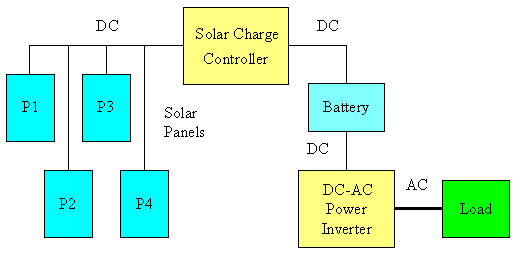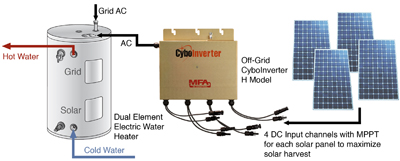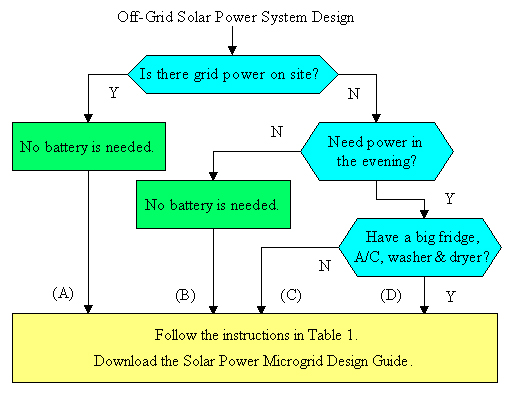A Solar Power Microgrid: With or without batteries
 Although energy storage-based microgrids are attracting a lot of attention and investment, there’s a niche for battery-less microgrids. There is a new type of off-grid solar power inverter that can be used with or without batteries. As there are many off-grid solar applications where batteries aren’t actually needed, battery-less microgrids are a possibility not previously offered in the industry.
Although energy storage-based microgrids are attracting a lot of attention and investment, there’s a niche for battery-less microgrids. There is a new type of off-grid solar power inverter that can be used with or without batteries. As there are many off-grid solar applications where batteries aren’t actually needed, battery-less microgrids are a possibility not previously offered in the industry.
In traditional off-grid solar systems, batteries are a necessity. However, batteries have ongoing maintenance requirements, and can be heavy and costly. As an alternative, battery-less microgrids offer real-world solutions that are efficient and cost-effective, especially for PV solar heating and solar cooking.
Traditional off-grid system
Figure 1 shows a traditional off-grid solar power system. Multiple solar panels are connected in series and/or in parallel to feed DC power to a solar charge controller, which charges a battery. A DC-to-AC power inverter, then, takes DC power from the battery and supplies AC power to the load.
Sounds simple enough, however, this system can entail the following shortcomings:
· As the battery is the central piece of this system, always at work even when the sun is shining, it has to be large enough to supply sufficient power for the load during an entire day and night. Often this results in a shorter battery life, due to ongoing wear and tear.
· Solar panels are connected in series and/or parallel, resulting in high-voltage and/or high-current DC. This can result in a problem, where the I-V (current-voltage) curve of the combined DC source doesn’t have a single maximum power point (MPP). This means an MPPT solar charge controller might not be able to find the MPP, resulting in poor solar energy harvest.
· In this case, there isn’t a real or reliable MPPT (maximum power point tracking). Combine that with partial shading concerns, and the solar charge operation is clearly not very effective. As a result, the system would require more batteries and a larger solar charge controller.
· Additionally, high DC current is risky and high DC voltage can arc and cause fires.
A new approach
 Figure 2 illustrates an off-grid solar power inverter that directly obtains DC power from solar panels, while generating AC power for the loads. In this system, the off-grid solar power inverter has four DC-input channels, which connect to four solar panels using MC-4 connectors. Each input channel has its own MPPT for each solar panel, so the solar energy harvest is maximized.
Figure 2 illustrates an off-grid solar power inverter that directly obtains DC power from solar panels, while generating AC power for the loads. In this system, the off-grid solar power inverter has four DC-input channels, which connect to four solar panels using MC-4 connectors. Each input channel has its own MPPT for each solar panel, so the solar energy harvest is maximized.
As an example of a battery-less microgrid application, a dual-element electric water heater can be re-wired to connect its lower heating element to the inverter AC output, leaving the upper heating element connected to the grid. To save electricity, the thermostat of the lower heating element would be set higher than the upper thermostat. This way, the grid power doesn’t turn on unless a lot of hot water is used during a short period of time. This simple off-grid system is easy to install and requires almost no maintenance but can assure a quick return-on-investment (ROI).
Microgrid design
Using a systematic approach, a designer can follow the flowchart in Figure 3. Based on the selected category, it’s possible to see different options and suggested approaches for the application. Table 1 offers further microgrid design approach examples.
|
Category |
Status |
Approach Examples |
|
A |
Has grid power; no battery’s required |
· Build microgrids without batteries to power single- or dual-element water heaters, air heaters, baseboard heaters, electric floor heating cables, mats, etc. |
|
B |
No grid power; but power isn’t needed at night, so no battery’s required |
· Build microgrids to power lights, fans, TVs, computers, sound systems, battery chargers, and small appliances for rural schools, stores, churches, clinics, etc. · Power electric cookware and hot plates for solar cooking in rural parts of the world. |
|
C |
No grid power; power’s needed at night, so a battery’s required (without heavy loads) |
· Estimate the required power for the day and night based on the AC loads, and · Select the proper solar panels, inverters, and batteries accordingly. |
|
D |
No grid power; power is needed at night (heavy AC loads) |
· Design the microgrids capable of powering the heavy AC loads.
|
Table 1. Microgrid design approaches
Conclusion
 Many people want to go off-grid because of increasing utility costs and/or a desire to incorporate more renewable sources of power into their homes or businesses. Even though there are more financing and leasing options available than ever before to go solar, costs can still be prohibitive. For example, batteries to help power typical household appliances alone can cost thousands of dollars. Few people have sufficient means to go completely off-grid.
Many people want to go off-grid because of increasing utility costs and/or a desire to incorporate more renewable sources of power into their homes or businesses. Even though there are more financing and leasing options available than ever before to go solar, costs can still be prohibitive. For example, batteries to help power typical household appliances alone can cost thousands of dollars. Few people have sufficient means to go completely off-grid.
New microgrid technologies make the lure of off-grid a possibility—and often without the expense of costly batteries. Similar to what mobile phones have done to wired phones, microgrids can also leap over traditional power grids. And, beyond availability in North America, new microgrid technology and products can also offer cost-effective solar power solutions to rural parts of the world, where billions of people are still living without electricity.
Dr. George S Cheng is the chief technical officer of CyboEnergy, Inc. Download the Microgrid Design Guide online at www.cyboenergy.com.
CyboEnergy, Inc.
www.cyboenergy.com
Author: Dr. George S Cheng
Volume: July/August 2014










.png?r=7514)

